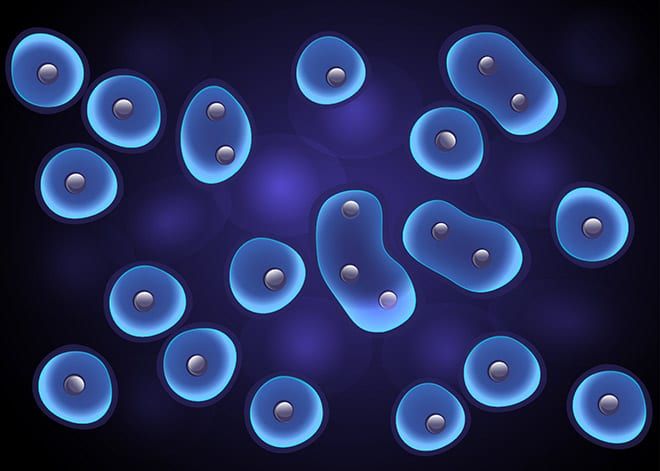Measuring the level of ageing
A topic of great interest to users, thanks to the media, is whether or not biological age can be determined using telomere data.
Biological age is a number that tells us whether our internal biology matches our physical years.. For example, I may have been alive for 48 years, but I may have an average telomere length equal to 42 years. The theory goes that this means I am, biologically, 42 years old.

Telomere data has many applications in health and wellness, and is extraordinarily useful.. By measuring the length of telomeres we can know the biological age of the person, their regenerative capacity and ultimately their biological health.
Biosalud Day Hospital offers Telomere Analysis, which is a blood test to analyse the length of telomeres.
Why do we want to know the length of our telomeres?
Firstly, to know to what extent my way of life is adequate or inadequate. should I make any changes that my doctor will recommend, so that I can live longer and better.
Secondly to confirm whether the changes introduced into my lifestyle, my diet, the nutritional supplements I take and the treatment prescribed by my doctor. serve to slow this shortening down. In this case, an annual analysis is carried out.
Thirdly, in order to assess my biological quality and that my doctor can personalise the treatment in the most appropriate manner from regenerative medicine for my joints or any other part of my body.
Research to rejuvenate our telomeres
According to scientists at the Stanford University School of MedicineThere is a procedure that can increase the length of telomeres, the protective caps at the ends of chromosomes that are linked to ageing and disease.
The procedure, which involves the use of a modified type of RNA, ribonucleic acidone of the 3 major macromolecules essential for all forms of life, will improve researchers' ability to generate large numbers of cells for study or drug development, scientists say. Skin cells with telomeres lengthened by the procedure were able to divide up to 40 times more than untreated cells.. Research may point to new ways to treat diseases caused by shortened telomeres.
Telomeres are the protective caps on the ends of the strands of DNA called chromosomes, which house our genomes. In young humans, telomeres are approximately 8,000-10,000 nucleotides long. However, they shorten with each cell division and when they reach a critical length, the cell stops dividing and dies. This internal "clock" makes it difficult to keep most cells growing in a laboratory for more than a few cell doublings.
Turning back the internal clock
"We have found a way to lengthen human telomeres by up to 1,000 nucleotidesThe Baxter Biology Lab, which has been working to restore the internal clock in these cells for the equivalent of many years of human life," said Helen Blau, PhD, a professor of microbiology and immunology at Stanford and director of the Baxter Laboratory for Biology at Stanford. Stem cells from the university. "This vastly increases the number of cells available for studies such as drug testing or disease modelling."
A document describing this research was published in January 2015 in the FASEB Journal. Blau, Donald E. and Delia B. Baxter are the lead authors. Postdoctoral researcher John Ramunas, PhD, of Stanford, shares lead authorship with Eduard Yakubov, PhD, of the Houston Methodist Research Institute.
The researchers used modified messenger RNA to extend telomeres. RNA carries instructions from genes in the DNA to the cell's protein-producing factories.. The RNA used in this experiment contained the coding sequence for TERT, the active component of a natural enzyme called telomerase. Telomerase is expressed by stem cells, including those that give rise to sperm and egg cells, to ensure that the telomeres of these cells remain in tip-top shape for the next generation. However, most other cell types express very low levels of telomerase.
The newly developed technique has an important advantage over other potential methods: it is temporary.. The modified RNA is designed to reduce the cell's immune response to the treatment and allow the TERT-encoding message to stick a little longer than an unmodified message would. But it dissipates and disappears in about 48 hours. After that time, the newly lengthened telomeres begin to progressively shorten again with each cell division.
On a biological level, this means that the treated cells do not go on to divide indefinitely, which would make them too dangerous to be used as a potential therapy in humans because of the risk of cancer.
This new approach opens the way to the prevention or treatment of ageing diseases.
An addition of 1,000 nucleotides represents an increase of more than 10 percent in telomere length.. These cells divided many times more in the culture dish than untreated cells: about 28 times more for skin cells, and about three times more for muscle cells.
Research like this demonstrates the importance of telomeres. From Biosalud, we would like to remind you of our recommendations for telomere lengthening and slow down ageing



2 thoughts on “Determinar la edad biológica de una persona”
I would like to know my biological age through analysis and necessary tests.
Comments are closed.